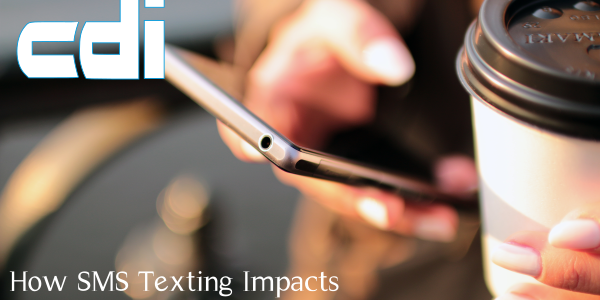[vc_row][vc_column][vc_column_text]By Gigi Peccolo
March 15, 2016 – Today’s customers want to engage with your business on more and more channels. In fact, a recent study by NICE Systems and BCG found that customers use an average of 5.6 channels to contact a company. And one of the channels they’re using is text messaging, a channel that’s been on the rise in recent years. A 2015 study from Pew Research found that despite the popularity of mobile apps, texting is the most-used app on smartphone.
Texting for Customer Service
When it comes to customer service, a 2014 Harris Poll Study found that 64% of customers would rather text than call for customer service. The aforementioned NICE study also found that texting is the highest-rated channel in terms of quality of experience, beating out other digital channels, as well as traditional service channels like voice and IVR.
 Texting is a great way to engage customers—it’s short, it’s quick, and it’s a channel that they’re already familiar with. In our experience, we’ve also seen that end users are demonstrably happier using text messaging during the customer service process, sending smiley faces to an agent while they’re texting with them.
Texting is a great way to engage customers—it’s short, it’s quick, and it’s a channel that they’re already familiar with. In our experience, we’ve also seen that end users are demonstrably happier using text messaging during the customer service process, sending smiley faces to an agent while they’re texting with them.
But texting isn’t just good at taking care of the customer after they’ve made a purchase—it can also help turn prospects into customers.
Texting Impacts Sales and Profitability
A few years ago, Velocify did a great study on how texting can enhance the sales process. You can view the full report here, but notable statistics include the following:
- Prospects who are sent text messages convert at a rate that’s 40% higher than those that aren’t
- Salespeople can improve conversion by over 100% when using texting properly
- Sending 3 texts after making contact can boost conversions rate by over 300%
Texting can also save your company money. Most phone calls can cost $6-20 per interaction, while texts can cost $2-3 per interaction. If you automate these messages, though, you can decrease the costs to just 25 cents per interaction.
Adding Texting to Your Business
As we’ve discussed, texting can be used for customer service and sales to better engage prospects and customers. But how do you get started with texting in your organization? There are a few steps you can take.
- Establish how you’ll be using texting in your organization. Will there be a lot of live agent interactions, such as in a concierge service, or will it be more automated, like outbound message blasts? Or, will you need both live agent interactions and automation?
- Establish if texting will need to connect with other channels. A lot of texting solutions are text-only—they don’t integrate with other communication channels like voice and web chat. If you’re looking for true omnichannel communication, you’ll want to find a solution that integrates with other communication channels for a more seamless customer experience.
- Establish your messaging volume. Are you going to be sending out 1,000 outbound messages every month, or will you get a lot of inbound messages from people subscribing to a text service? Forecasting your messaging volume will help you better estimate costs.
- Do your research. There are a lot of texting solutions out there, so find one that accommodates the three points above.
- Sign up for a trial, or, if it’s a larger scale project, run a pilot. Most organizations will let you sign up for a free trial that lasts two weeks or a month. This is a great way to establish how texting will work in your organization without having to commit fully.
Conclusion
Texting can be used to great effect in sales and customer service. But whatever you decide to use it for, know that it’s easy to add to your organization and is a cost-effective and preferred channel for customer communication.[/vc_column_text][/vc_column][/vc_row][vc_row][vc_column][vc_column_text]About The Guest Author
 Gigi Peccolo is the Content Manager at OneReach, where she is focused on creating content enabling companies to offer effective, meaningful customer support over voice and text message.
Gigi Peccolo is the Content Manager at OneReach, where she is focused on creating content enabling companies to offer effective, meaningful customer support over voice and text message.
Gigi is a skilled writer and editor, and her work has been published on multiple industry sites. Gigi received her BA in Journalism Studies and Spanish from the University of Denver, where she graduated with Distinction in Journalism Studies.[/vc_column_text][/vc_column][/vc_row]

